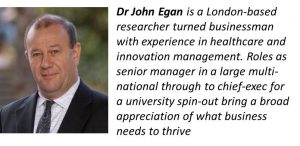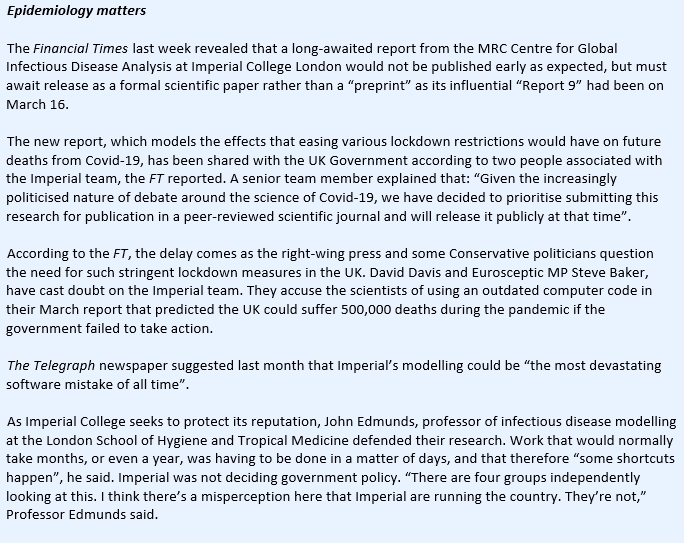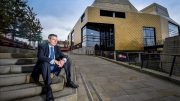In the third of a Chief-Exec.com series on the coronavirus, Dr John Egan looks at the vital role of the epidemiologist – the men and women who investigate patterns and causes of disease and their impact on public health.
In these troubled times, spare a thought for epidemiologists.
These are people who often sport the words “public health” in their official title. Their job is to issue advice which, if adopted by their government, aims to make their own predictions wrong.
Several have been catapulted into the media with advice that some may find counter-intuitive and questionable. Yesterday, The Times reported that Dr Jenny Harries, the deputy chief medical officer for England since June last year, said that people should limit themselves to what was sensible rather than what was possible, and called for common sense. But what is sensible for the population as a whole may not make sense to an individual.
Imagine that you live in London but own a second home in an isolated rural setting. Let us say you suspect you may already have contracted the Covid-19 coronavirus disease. If you can get to your country residence with a low risk of passing the disease onto others and then see off the disease without further contact, then surely it is common sense that this provides the safest outcome for all.
Let’s imagine a good part of London’s residents did this. The diaspora would multiply all those insignificant individual risks, making a rampant expansion of the disease across the rural landscape – where health services are least able to deal with it – quite probable.
The politicians say they are following the science, but science itself is uncertain because so much is unknown about the coronavirus and the Covid-19 disease.
The epidemiologists must appeal to a collective common sense.
To do this they work with “models”, often in the form of computer algorithms, that calculate patterns of the spread of disease during epidemics. They validate the predictions their models can make by comparing these simulations with bygone episodes.
As far as the model appears to mirror the real world, it gives a degree of confidence that it may be useful to better understand the “parameters”, which are the important factors that determine how a virus spreads and how it may be controlled. With any virus the basic reproduction number R0 is an important parameter that signifies how many people on average a newly infected individual will go on to infect. If R0 is greater than 1 then the number of infections increases exponentially.
In fact, R0 is a single number that brings together all the parameters of the Severe Acute Respiratory Syndrome Coronavirus 2 (SARS-CoV-2) that causes the Covid-19 disease, to summarise the effectiveness of measures taken to control its spread. In France, a period of enforced confinement from 17 March until 11 May 2020, resulted in a reduction of R0 from 2.90 to 0.67 as detailed in Science.
‘Too much relaxation and carelessness, and it’s a second wave looming; too much immobility and anxiety, and it’s collective suffocation. This is the mountain ridge along which we must advance: on each side there is a vertiginous drop’, Édouard Philippe, Prime Minister of France.
Individual choices to limit social interactions and wear masks, together with the closure of schools and parks, tele-working whenever possible, closing cafes and all other places where people might gather and a ban on all events, have togetheer achieved their goal and a gradual reopening of French society has begun.
Epidemiologists can predict the consequence of these changes with their model societies made up of numerous groups or compartments: the young, the old, the healthy, the infected, the asymptomatic, … for whom the causes and consequences of the disease may differ. Other models will split these groups into hundreds of thousands of individual agents, each with diverse behaviours that together represent an entire population. The highly influential paper from the MRC Centre for Global Infectious Disease Analysis at Imperial College London belongs to this latter group (see box).
Under the spotlight, more than 2,000 pre-print publications on the epistemology of SARS-CoV-2 have been placed on the medRxiv.org archive since February 2020. Each paper addresses a different question, with different hypotheses and using different equations. The glacial progress of science review has been overtaken by the urgency of the health crisis. Quality assurance and transparency cannot be guaranteed as fame and funding await success in the discipline.
Fitting these models to historical data is one thing. Using them to predict the future, when these predictions may affect the future that is predicted, is as much an art as a science. Modelling hundreds of thousands of computerised agents, controlled by hundreds of parameters, adding in random variations to rerun a simulation hundreds of times – the interpretation of the typical outcome is an alchemy of statistics and intuition.
The result is a tentative future vision based on many assumptions accompanied by much uncertainty. In March the University of Washington School of Medicine predicted that the number of deaths in the United States up to June could vary from as low as 38,000 to as high as about 162,000.
An anxious public want their politicians to guide them to safety and prosperity. The politicians say they are following the science, but science itself is uncertain because so much is unknown about the coronavirus and the Covid-19 disease.
What are the proportions of asymptomatic carriers and so-called “super spreaders”? Can children spread the disease? Will the virus be supressed in the warmer weather of summer? Are there effective medical treatments? What is a safe distance of individual physical separation? What are the other dangers to health of confinement? What are the medium and long-term health consequences of SARS-CoV-2 infection?
In early May, French Prime Minister Édouard Philippe explained the relaxation of his country’s lockdown thus: “Too much relaxation and carelessness, and it’s a second wave looming; too much immobility and anxiety, and it’s collective suffocation. This is the mountain ridge along which we must advance: on each side there is a vertiginous drop”.
There is still much to learn about the virus before epidemiologists can translate their models into sound public health policy. The public needs to recognise this, yet still allow themselves to be guided by their collective common sense.
To do otherwise will lead to many unnecessary deaths.
For related articles on Chief-Exec.com : Click Here

Headline Photo Credit: theskaman306/Shutterstock.com





